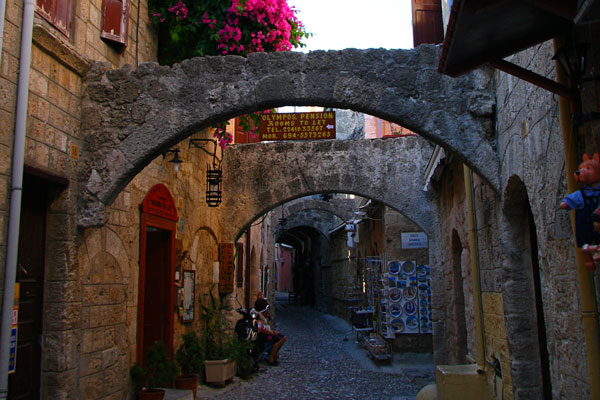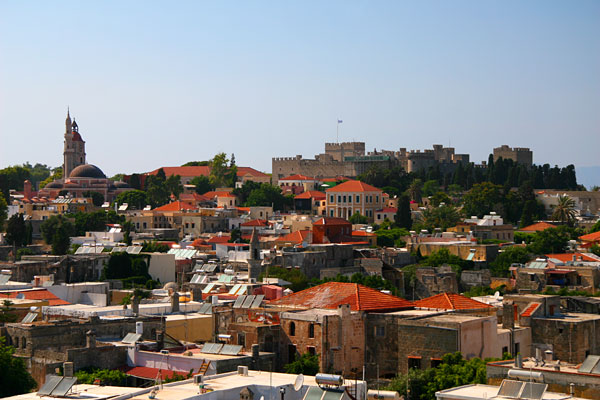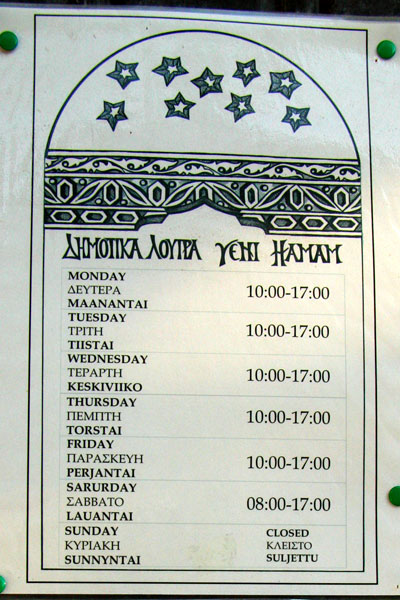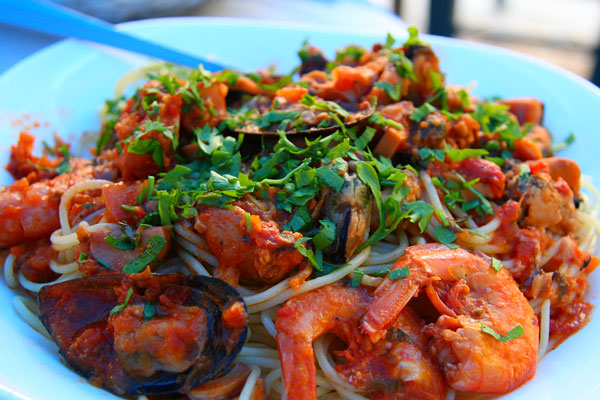
Our first glimpse of the walled city of Rhodes (Rodos) came shortly after the sunrise as our ferry slowly sailed into the busy Mandraki harbor. Through the summer haze the magnificent bastion emerged behind the masts of modern yachts and tropical palm trees -- reddish, looming and more colossal than in my imagination. Something just didn’t quite fit my skewed impression of whitewashed Greece Islands -- this was almost a Pingyao, or perhaps more like a Carcassonne, dropped right onto the eastern edge of the Aegean Sea.

From the circular fort in the harbor to the gargantuan defensive walls to a moat wide enough for soccer for the town’s children, everything alluded to a long history of warfare, or at least of active deterrence. This was, after all, the near-impregnable stronghold of the Knights Hospitallers, who brought their French fortification engineers to this eastern realm of the Mediterranean to construct a seaside fortress to rival the naval powers of the day. For a couple hundred years these walls turned back a multitude of invasions until the golden age of the Ottomans, some 500 years ago.

The walls and gates were never breached by force, and instead the Knights were allowed to vacate freely and eventually move to Malta. The peaceful resolution ensured the preservation of the 15th Century architectural details, including the massive turrets and crenellations as well as much of the old town. For the modern day visitor it still is a complete medieval city in the finest traditions of Western Europe, except for its curious location right next to the Turkish coast.

The Knights left their marks with their immense defensive structures and Gothic town, followed by the Ottomans with their geometric ornamentations, mosques and bathhouses, culminating with an Italianate palace courtesy of Mussolini. Part French, part Turkish, part Italian, and part Greek -- there is simply no other place in the world possessing this marriage of styles. We'd been looking forward to having this UNESCO World Heritage Site as our last stop on our 18-day trip through Greece.

The major attraction for us was spending a few days within the oldest inhabited medieval town in Europe. The architecture of the old town appeared so influenced by medieval France that we could easily imagine ourself in the Dordogne, except for the greenery of palm trees growing haphazardly around street corners.

Walk into any side alley in the old town and you’ll be surrounded by hewn stone walls supported by Gothic flying buttresses, with cute wooden balconies overhanging the narrow cobblestone paths. It was time to ditch the maps and lose ourselves in the maze.

As the medieval town itself was the focus of our stay, we didn’t pay extra to see any of the sights in town apart from the Grand Master’s Palace. Occupying the highest point of the old town, the palace offers some great views of the lower part of the town, not to mention an escape from the 35-degree heat outside.

While some visitors shun the Grandmaster's Palace for its dubious reputation as an unauthentic, 20th Century Italian reconstruction of the Knights’ old headquarters, that plastic surgery of the exterior mainly affected the pseudo-medieval appearance of its walls and rampart. The best, authentic stuff are still inside its grandiose halls.

Most impressive were a number of beautiful 2000-year-old mosaic, pillaged by the Knights from various neighboring islands in the Aegean and brought here to embellish the flooring of their leader's grandiose residence.

This might have become another Elgin Marbles dispute if Rhodes didn't end up with the Greeks in 1948. Now these sublime mosaics continue to greet their admirers as part of a well-protected, and most importantly, Greek UNESCO site, and there doesn't seem to be any plans to return them to Kos and Chios yet.

Leading from the palace back to lower town was the picturesque Street of the Knights, a wide, cobblestoned medieval boulevard lined with 15th Century quarters of the Hospitallers. This is all aesthetically pleasing and it's understandable why the tourism industry always bills the Grandmaster's Palace and the Street of the Knights as the main draws. But these only represent a segment of history left behind by French and have little to do with the daily lives of the town's modern inhabitants. Fortunately something much more authentically local is just around the corner ...

By far my favorite activity was visiting the town’s old Ottoman Hammam, i.e. public bathhouse. I know what you're thinking ... yes this is linked to a period in Greek history that many locals would rather forget, which probably explains why so few Turkish bathhouses remain in operation within Greece today. But Rhodes is just 25km from the Turkish coast, and the Yeni Hamman still serves the several thousand ethnic Turks remaining on the island today.

I haven't been to a Turkish bathhouse since Rudas in Budapest a few years back, but the procedure was simple enough: bring own towel, deposit valuables and clothes in the locker, and head straight for the steam bath. The attendant of the day was curiously an elderly English gentleman, who nonetheless gave me a very thorough scrub of everything I accumulated through two-and-a-half weeks of backpacking.

The locals really know how to relax! I didn't realize it at the time, but according to my camera's timestamps I must have spent about 3 hours in the bathhouse on one afternoon. IMHO this is an excellent sightseeing strategy as well -- refreshing yourself inside the Hammam away from the scorching afternoon sun, then head back out to explore more the town in the cool of the evening.

I'd probably rank Rhodes right behind my favorite Greek islands of Symi and Santorini. While it's true that parts of the walled city has been completely overrun with tourist-gouging restauranteurs and cheezy souvenir stands, the medieval town itself is large enough to foster the survival of authentic, sleepy neighborhoods for a glimpse of the good life prior to the arrival of mass tourism. For its unique combination of medieval romance, laid back Mediterranean vibe, and of course great local food, it's difficult to beat this remote southeastern corner of Greece.

















